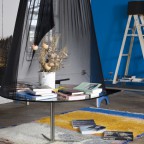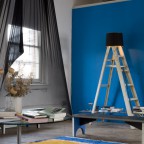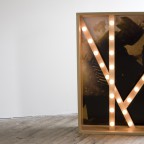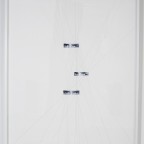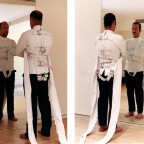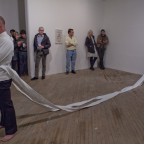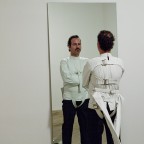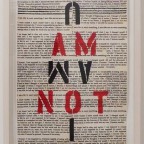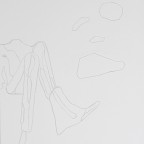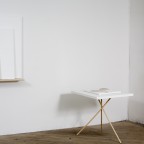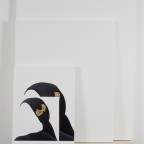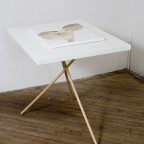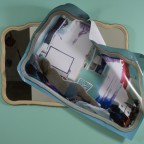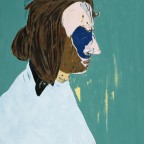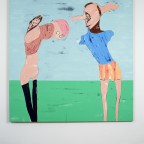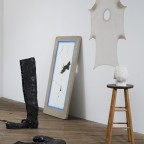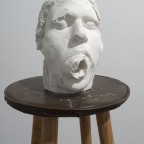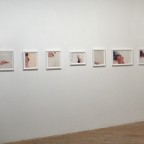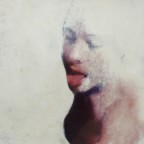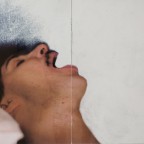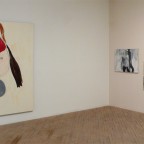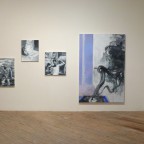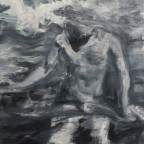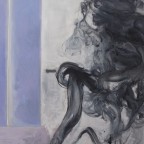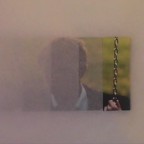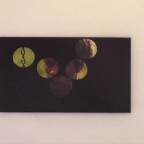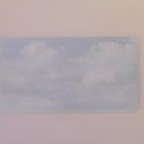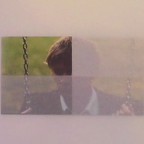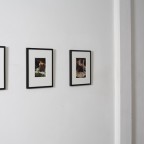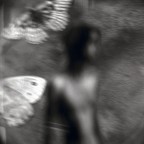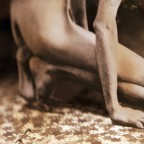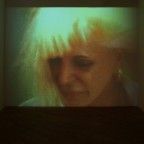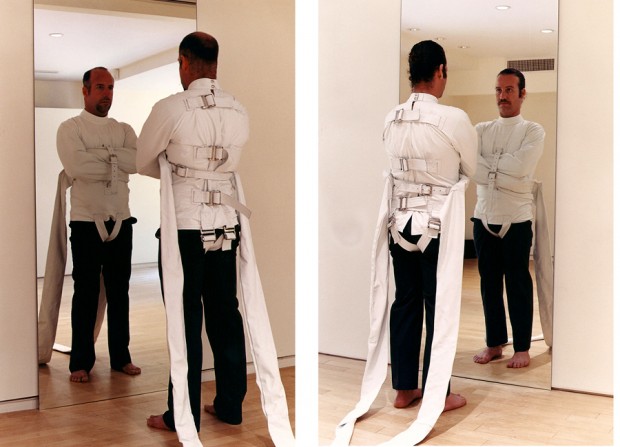
Graham Durward, Alexandra Gorczynski, Stephen Irwin, Paul Lee, Lovett/Codagnone, Franklin Preston, Matthew Savitsky, Marc Swanson, Scott Treleaven, Nicola Tyson
Nico: Do you find there’s a similarity between us?
Randy: Uh, not really, no.
Nico: No?
Randy: No, your hair is much longer than mine.
Nico: Not really.
[From Andy Warhol’s The Closet]
Kick in the Eye is a group exhibition of recent painting, drawing, sculpture, installation, photography and video that features artists who engage fractured ways of looking and being seen. Through sideways glances, misidentification, and quiet confrontation, these artists create queer portraits, broken mirrors that deny easy absorption of difference and call into question what we might think we know about processes of identification. What can be activated in a viewer through deliberate masking, hiding, coding, covering, or abstracting?
These artists illustrate the fact that leisured looking is a position of power and posit instead that the slippery back-and-forth of identification resulting from looking made difficult may be a subversive and generative act. In his introduction to Homos, Leo Bersani calls for “an anticommunal mode of connectedness we might all share, or a new way of coming together,” which “should be the goal of any adventure in bringing out, and celebrating, ‘the homo’ in all of us.” The works set up the possibility for a form of connection and identification that relies on elusiveness, and comes from solitary practices like painting and home-based video production. They represent a queer sensibility, as Douglas Crimp has put it, “not based on the model of the couple, the two-coming-together-as-one, the you-and-me-against-the-world model.” As viewers we enter aware of our non-participation; we see otherness, we confront strangeness, and we see ourselves.
Nicola Tyson’s large-scale, colorful paintings are at once elegantly beautiful and grotesque, psychological portraits of the unconscious and manipulations of bodily form. Graham Durward presents a series of new paintings that are based on found photographs of men cruising the Internet or of burning incense. They are simultaneously analytic and poetic and express solitude and desire through implied connection. Franklin Preston calls his paintings portraits of the psyche; they employ minimal, layered elements to suggest stages of psychic isolation. Stephen Irwin is represented by a series of vintage porn magazine pages, which he manipulated by rubbing parts of the image away, leaving a more suggestive and expansive erotic landscape.
Paul Lee and Alexandra Gorczynski’s video works use hand-made techniques to explore the self-construction of identities through relationality. Scott Treleaven’s Last 7 Words is a quiet video portrait of pandrogynous artist Genesis Breyer P-Orridge, and his intimate portal photographs illustrate a blurred sense of longing while looking.
Matthew Savitsky’s sculptural installation represents an absent body in play with the viewer, making reference to sex and obsession. Marc Swanson’s drawings literalize the complexities of exchanged glances, and his sculptural/photo work recalls a cinematic space of desire and identification. Artist duo Lovett/Codagnone, through their performance on opening night and resulting sound piece and installation, question ideas of coupling and explore the dissolution and/or fusing of individual egos.
An associated film screening will take place on April 8 and 9 at the Ibrahim Theater at International House.
April 8 The Closet, Andy Warhol (1966, 66 minutes)
Blue, Derek Jarman (1993, 79 minutes)
April 9 Bijou, Wakefield Poole (1972, 77 minutes)
Community Action Center, A.K. Burns and A.L. Steiner (2010, 69 minutes)
In addition to the works on view and film screenings, a discussion space designed by artist Matthew Savitsky will be activated throughout the course of the exhibition by a series of intimate talks on related themes. A schedule will be posted on the Vox Populi web site. When not in use for discussions, the space will function as a research/reading room with materials available for perusal chosen by the curator and the participating artists.


